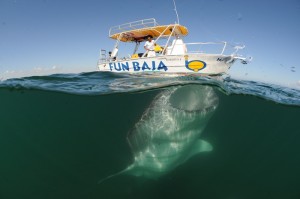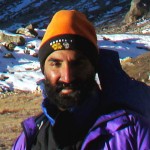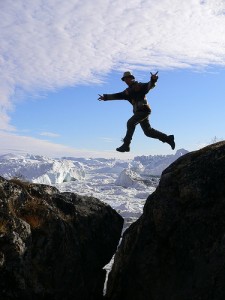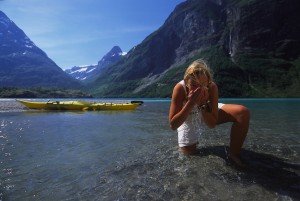
 Luis Palacios - Director, Baja California Sur Tourism Board
Luis Palacios - Director, Baja California Sur Tourism Board
Definitely the fact that the main destinations of Baja Sur such as Loreto, Los Cabos and La Paz will focus their campaigns in selling experiences rather than the usual packages of sun and sea, which are also important. The different destinations understand that tourism now is based on the ability of the destination to provide unique experiences [such as] swimming with the whale sharks in La Paz or experiencing the aquarium of the world in Loreto - this is what we feel will make a difference and all efforts are directed on sharing these experiences with the world.
 Tejbir Singh Anand - President, Adventure Tour Operators of India
Tejbir Singh Anand - President, Adventure Tour Operators of India
The changing trends in consumer behavior are short but frequent holidays, family oriented getaways, corporate adventure trips and experiential trips for schools. The market share has increased and is expanding with every year passing. Active holiday demand is growing, and so are our marketing budgets. We are currently looking at short-term marketing strategies and less at long term.
 Anna Dulina, Kamchatka Region Ministry of Sport and Tourism, as interviewed by Mark Dudley - Sales Manager, North America of VLADIVOSTOK AIR AMERICA, INC.
Anna Dulina, Kamchatka Region Ministry of Sport and Tourism, as interviewed by Mark Dudley - Sales Manager, North America of VLADIVOSTOK AIR AMERICA, INC.
One of the global trends in tourism that we are monitoring is the increase in ecological and adventure travel in nature. There is growing interest in new destinations, especially ones featuring truly wild nature, favorable ecology, clean water and fresh air. These are exactly the resources that Kamchatka has to offer in abundance.
Another trend is the significant growth of outbound Chinese tourism, which we plan to take advantage of. The Chinese travel market is the fastest developing in the world. In order to attract part of this constantly growing flow of tourists, Kamchatka is actively cooperating with Chinese government tourism offices and tour operators, conducting promotional tours and making presentations, and developing direct flights from China. Kamchatka is focused on developing travel exchanges with countries of the Asian-Pacific region, and is trying to study and understand the needs of travelers from the USA, Japan, South Korea, and China so as to adapt our travel product to the each country's preferences and expectations.
 Stacey Mitchell - Director of Sales, Florida Keys & Key West Tourism Council
Stacey Mitchell - Director of Sales, Florida Keys & Key West Tourism Council
The most important influencing factor on our marketing decisions/spend with regard to the promotion of the Florida Keys & Key West as a vacation destination is consumer confidence and the economy. This applies to domestic and international markets.
 Ms. Maria Claudia Lacouture - President, Proexport Colombia
Ms. Maria Claudia Lacouture - President, Proexport Colombia
1. The economic crisis in European countries and the United States has led us to shift our international promotion strategy, having a greater focus on regional emerging countries.
2. Changes in the consumers purchasing process of international travel. The internet has changed the booking process and consumers are now self-booking directly with suppliers or through network carrier websites where Colombia is promoted as a first class international destination. Colombia will embrace the world online to ensure that product is offered through multiple channels across the globe. Social networks and the internet are changing the habits of travelers.
3. Similarly, changes in the desires and demands of tourists, who are increasingly looking for unique and authentic experiences, led us to evaluate tools that enable Colombian businessmen to identify, learn and adapt its product to those international trends related to unique and authentic experiences (tailored trips). For 2012, PROEXPORT initiated a process with Colombia’s Small and Medium Enterprises (SME's) to learn about, endure, and through their experience, adapt their products with the latest international trends. With national associations we will be conducting training and workshops to ensure that businessmen have access to information and advice on international trends. In addition, our international promotion is focused on promoting value-added products that offer unique experiences such as nature tourism (bird, dolphin, and whale watching, etc.) or Premium Tourism (boutique hotels).
 Mr. Digu Naobeb - CEO, Namibian Tourism Board
Mr. Digu Naobeb - CEO, Namibian Tourism Board
Given the economic challenges facing our largest source markets – German-speaking Europe, the UK, France and Italy – where disposal income is down and so are the number of tourists traveling, competition is therefore greater for a smaller number of tourists. We are still investing in these markets in order to maintain our presence, but we are also looking to invest in new markets.

 Sthu Zungu - President, North America, South African Tourism
Sthu Zungu - President, North America, South African Tourism
There are several macro and consumer trends that will affect our marketing spend in the next 18 months and these are namely:
- Our research shows South Africa’s total brand awareness among our American target markets at an all-time high, following the successful hosting of the 2010 FIFA World Cup. This means more and more people are searching and enquiring about the destination, which begs the question for improved information provision on our part.
- While the 35+ year olds is our traditional primary market, recent results show growth in the 18-34 group outpacing 35+
- The use of social media such as Facebook and Twitter has got consumers more engaged than ever. South African Tourism’s Facebook page now has over 112,000 followers and allows us to interact with our consumers on a daily basis, but also facilitating open sharing of tips amongst those who have been and those considering making the trip. We are also able to promote offers and deals to those who are seriously searching.
- There is also a rise in family travelers for South Africa which is a great enhancement to our traditional segments.
- Eco-tourism and issues of sustainability continue to be central amongst our segments and so we continue telling South Africa’s incredible story of leadership in this area.

 Anders la Cour Vahl - Deputy Director, Visit Greenland Ltd
Anders la Cour Vahl - Deputy Director, Visit Greenland Ltd
Following the launch of Greenland's new brand "Pioneering Nation," where we have fully committed us as an adventure destination, we have noticed a shift in our appeal in the markets. We have experienced a clear growth in interest from the North American market, but also noticed enquiries from new agencies and individuals on old markets such as Denmark and Germany. Most notably we see a significant shift from the traditional marketing platforms like brochures, trade shows and phone calls toward a much more online based interaction. As a consequence we will over the next 18 months move resources from offline marketing to social media campaigns and development of designated sites for special groups, such as our new Extreme Adventure site, 99Backcountry.com, which will be launched this spring. Later this fall we will activate the Pioneering Nation brand in a new concept, called The Big Arctic Five, which we expect much from.
 Alex Herrmann - Director Americas of Switzerland Tourism
Alex Herrmann - Director Americas of Switzerland Tourism
We see more interest in all kinds of active vacations, especially in what has traditionally been called "soft adventure." New ways to explore the country, such as traveling by e-bike (electric bicycle) or canoeing, broaden the potential base of active travelers. More families and affluent travelers choose a vacation with active components, often in combination with upscale accommodation, a focus on food & wine, or a spa experience.
Generally shorter stays and the combination of Switzerland with a neighboring country such as Italy are supported by the fact that Switzerland is small, and everything is very close. It's easy to get around, thanks to an excellent public transportation system, so visitors can have a maximum of experiences in a short time frame.

 Todd Davidson - CEO, Travel Oregon
Todd Davidson - CEO, Travel Oregon
DOMESTIC
Outlook: Moderate gains in domestic leisure travel. International arrivals outpacing domestic trips.
Consumer Trends:
- Aging of the American population and their needs for soft adventure tourism
- Changing ethnicity make-up of the U.S. population and their wants for adventure tourism and outdoors in general
- increased desire for authentic experiences
- experiences that are personalized, unique and undiscovered.
Customer service: make travel planning not just easy but fun (every consumer interaction presents an opportunity to surprise and delight and these positive encounters have a growing opportunity to be shared through social media).
- Recent studies by Forrester show that travelers are increasingly frustrated by the “clinical and intimidating” experience afforded by online trip planning sites. For the first three months of 2010, 28% of leisure travelers in the U.S. who booked their trips online said they'd be interested in going to a good traditional travel agent. That's up from 23% in 2008. In addition, the number of leisure travelers who enjoyed using the Web to plan and book their vacations dropped to 46% last year, down from 53% in 2007
- Site Ask Oregon as an example: The “Ask Oregon” program is a strategy to deliver visitor information to travelers by connecting them to passionate Oregonians using multiple touch points including TravelOregon.com, Facebook, Twitter, our call center, Trip Advisor, & Visitor Centers
- As technology creeps deeper into consumer’s lives, the need to disconnect and reconnect with family and the outdoors will become more important to consumers.
INTERNATIONAL
Outlook:
- International visitors to the U.S. were up 13.5% in 2011 over 2010, travel exports totaled $139.4 billion in 2011.
- The U.S. Department of Commerce (DOC) projects international travel to the United States will continue experiencing strong growth through 2016
- According to the current forecast, the United States would see 5 percent annual growth rates in visitor volume over the 2012-2016 timeframe. By 2016 this growth would produce 81 million visitors, a 36 percent increase and an additional 22 million visitors compared to 2010
- Corporation for Travel Promotion, a nonprofit entity doing business as Brand USA, is promoting international leisure, business and scholarly travel to the United States
- January 2012 the President announced an executive order designed to reduce the time it takes for travelers from China and Brazil to get visas to the USA
- Quarter 3 of 2011 over Quarter 3 of 2010, international visitors to Oregon were up 10.9%
- The international travel market is very lucrative with average spending five times higher than domestic travelers
- European inbound travel to the U.S. has declined primarily in the U.K. and German markets, however, this has not greatly affected Oregon, as a second/third tier destination, our demographic is more affluent and more likely to continue to travel, our tour operator numbers and VisaVue® support this
- European consumers are asking tour operators for adventure activities that can be booked inclusive in their travel package, this offers opportunity to Oregon outfitters to pre-sell their high season and price shoulder season product aggressively
- Domestic adventure travel trade groups are trending smaller, looking for themed activities, like kayaking and wine tasting
- The Asia traveler is staying to the “safe activity” like guided bicycling or hiking tours, not extreme activities
- Australian travelers are very adventurous and more likely to participate in extreme adventure sports
- Canada travelers are also very adventurous and more likely to participate in extreme adventure sports. Oregon’s close proximity to B.C., allows the travel market to transport their own equipment
 Maria del Carmen de Reparaz - Director of Tourism, PromPeru
Maria del Carmen de Reparaz - Director of Tourism, PromPeru
In PromPeru we are constantly monitoring global consumer trends and contexts in order to align our marketing strategies to obtain the best results and achieve our promotional objectives. Among these consumer trends we have identified and targeted travelers seeking exclusive tourism, environmentally friendly and sustainable tourism, unique experiences, and nature seekers, among others. We are also taking into consideration trends resulting from new technologies such as online booking, thus incorporating these opportunities and challenges into our strategy.
The world economic context is also a variable that affects our strategies directly. Facing a positive trend of economic growth in Latin America, we are certainly focusing on promotional activities within the region to stimulate incoming tourism from these markets. Moreover, we have identified new markets such as the Nordic countries, Russia, China, South Korea, Holland and Switzerland; so we will be investing more resources in those regions.

 Kristian B. Jorgensen - CEO, Fjord Norway, Tourist Board of the Fjords
Kristian B. Jorgensen - CEO, Fjord Norway, Tourist Board of the Fjords
We have several trends affecting our marketing. First of all, the financial situation in Europe has made us focus more on markets close to home. Germany, Holland, UK, Denmark and Sweden have become our most important markets as a consequence of the unstable situation. Furthermore we are focusing more and more on customers that are motivated by what to do instead of where to go. This has increased our spending towards more typical adventure travel consumers. We have started investing more together with large outdoor retail brands trying to bring our destination higher on the awareness scale towards consumers focusing on hobbies and passions, rather than travel. Helly Hansen and Fjord Norway have just partnered up and will be launching a global campaign in 2012.
We are also spending less money promoting our destination, but more money selling it through large international tour operators. The competition is hard out there, so we need to close the gap between creating awareness and converting to sales. Finally we see the need to conceptualize our destination much stronger within activities. This gives an opportunity to work on building better experiences in the region within certain adventure areas, and market these more aggressively knowing that we can deliver great products and experiences in our region within the concepts we have built.
 Carla Portalanza - Markets Director, Ecuador Ministry of Tourism
Carla Portalanza - Markets Director, Ecuador Ministry of Tourism
Our marketing decisions are based on the study of different segments of tourists, and their varied interests, that have been coming to Ecuador in the last few years. The analysis looks at visitors’ spending in Ecuador as well as their travel preferences and activities. This analysis further confirmed that the economy has greatly affected international tourism to Ecuador and we are looking at ways to make adventure tourism in Ecuador more affordable while better meeting the travel requirements and interests of our visitors. In addition, social networks play a key role in our marketing decisions because they enable us to be even more aware of consumer preferences and therefore we are able to better cater to their needs.
